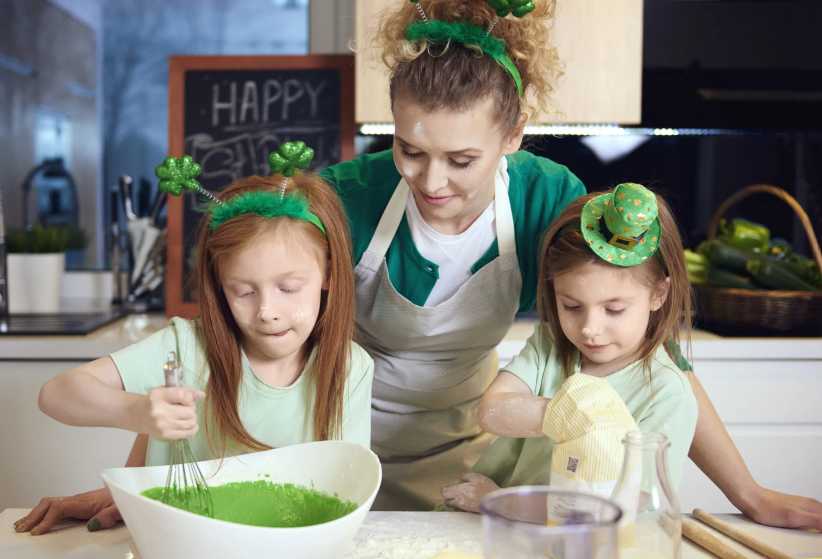Between the Internet and misinformed friends and daycare providers (maybe even Grandma), there’s plenty of nonsense floating around about rules when feeding children. Let’s explore some of the biggest ones.
Myth one: Children need special, kid-friendly foods.
Reality check: Kids can learn to eat almost everything parents do.
Some experts blame the food industry for its brilliant marketing, convincing us that little ones will only eat kiddie foods — highly-processed, sugary, salty and bland foods, or so-called fast foods.
It’s also a myth that they prefer bland food. Children brought up in Mexico or India eat spicy food starting when they are toddlers.
Allow your little one to experiment with food. You may think of this as “wasting” it, or bad manners, but playing with and even spitting out food is part of the overall sensory experience. Remember, many of the foods he’s tasting are brand new to him. Even the same food prepared in a different way — such as cooked carrots versus raw — can be totally foreign to a little one.
Myth two: Parents decide how much a child should eat.
Reality check: It’s the job of the parent to provide healthful food. And it’s the job of the child to decide how much to eat, according to renowned feeding specialist, Ellyn Satter (www.EllynSatter.com).
Part of the problem? Many adults don’t know what a proper portion looks like for themselves. So they may need even more help identifying the right amount for their children.
Myth three: Children need constant snacks.
Reality check: While some snacking is beneficial, kids today typically engage in all-day-long eating. According to a recent study on 31,000 children ages 2 to 18, they’re eating an average of three snacks every day, with desserts and sweetened beverages being the major source of calories.
What should your child’s snack consist of?
“Snacks shouldn’t be so-called ‘snack foods.’ They should be foods you would serve at any other meal, not a pile of orange fish-shaped crackers and a sugary juice drink,” says registered dietician Elizabeth Ward, a mom of three and author of “The Complete Idiot’s Guide to Feeding Your Baby and Toddler.” She says a quarter of a sandwich and half a glass of milk or 100 percent orange juice would be a better choice.
Myth four: Sugar-sweetened foods cause “hyper” kids.
Reality check: Contrary to the opinion of some parents and teachers, sugar does not cause hyperactivity.
Children who indulge in sugary treats during parties may appear to get wilder than usual. But there are no scientific studies to prove that sugar equals hyperactivity. In fact, sugars — like all carbohydrates — actually have a slight calming effect. It’s actually the holiday, birthday party or special activity that tends to get kids overly excited. [Editor’s note: For more information about the reported links between candy and hyperactivity, see “How to Create Healthy Easter Baskets” in our April 2011 issue. www.webfamilyny.com/stories/2011/4/fp_easterbaskets_2011_04.html]
Myth five: Veggie haters have nutrient deficiencies.
Reality check: “Veggies are not the end all, be all,” says Jill Castle, RD, a child nutrition expert who blogs at Just the Right Byte, and a mother herself. Many fruits supply the vitamins, minerals and phytonutrients that kids need to grow well.
“While we want kids to eat a variety of both fruits and vegetables, this is a work in progress. In the meantime, make sure fruit options make an appearance at meals and snacks — you’ll please your child and ease your worries,” Castle says.
Still, it doesn’t hurt to serve vegetables in a child-friendly manner. Serve them raw, cut into attractive shapes, call them fun names, or serve alongside a dip.
Resource: KidsEatRight.org.
Christine M. Palumbo, RD, practices nutrition in Naperville, IL. She invites your questions and column ideas. Contact her at Chris@ChristinePalumbo.com, or follow her on Facebook at Christine Palumbo Nutrition.
Breakfast Banana Split
(Serves one)
INGREDIENTS:
1 medium banana, sliced lengthwise
1/3 cup non-fat strawberry yogurt
1/3 cup non-fat vanilla yogurt
2 tablespoons chopped walnuts
DIRECTIONS: Place the banana, sliced lengthwise, in a bowl. Top with the non-fat strawberry yogurt and non-fat vanilla yogurt. Sprinkle with chopped walnuts.
NUTRITION: 332 calories, 10 grams protein, 55 grams carbohydrate, 4 grams fiber, 11 grams fat, 1 gram saturated fat, 100 milligrams sodium.
From “When to Eat What,” by Heidi Reichenberger McIndoo, MS, RD, LDN. Copyright © 2011, F+W Media, Inc. Used by permission of Adams Media, a division of F+W Media, Inc. All rights reserved.






















